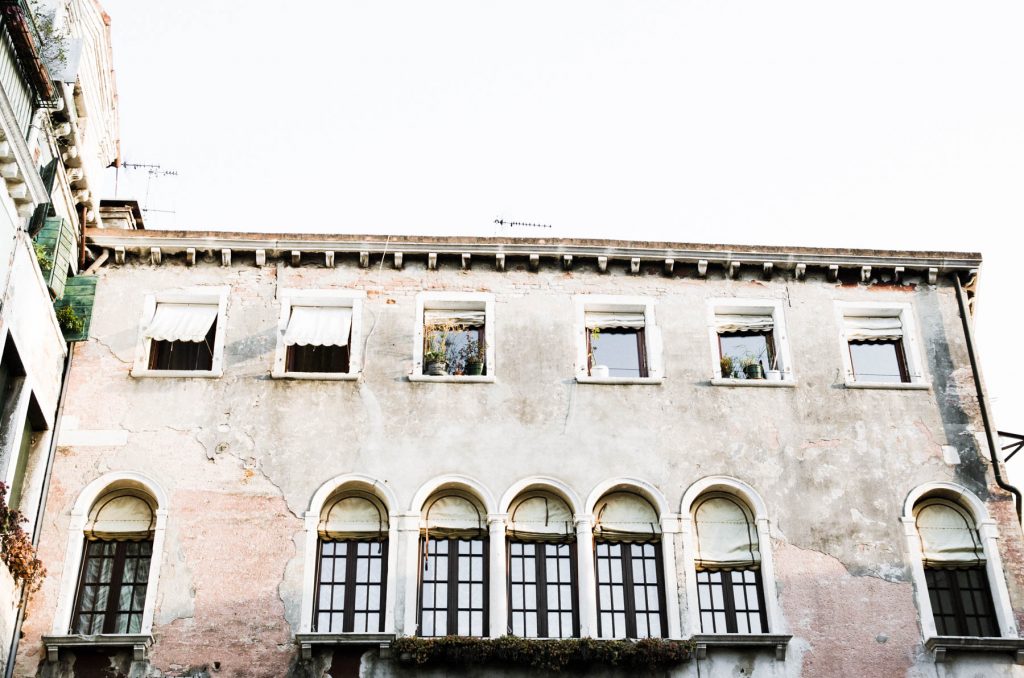Quando si è abituati a camminare immersi nella storia, quando basta alzare lo sguardo per vedere torri medievali, guglie o capitelli può capitare che si diano per scontate la bellezza e l’armonia che il passato ci ha regalato. Ma quando cogli lo sguardo di chi a tanta bellezza e armonia non è abituato, inizi anche tu a guardare con occhi diversi ciò che hai davanti. È per questo che tornare con amici stranieri in una città visitata anche più volte non mi pesa mai. Ogni volta, attraverso i loro sguardi e la loro meraviglia, ritrovo il mio stupore. Abbiamo accompagnato la nostra ragazza americana a Venezia, dove ho cercato itinerari meno battuti dalla massa di turisti che, ultimamente, mi dicono, assalgono la città per frequentare le boutique più esclusive nei pressi di San Marco, senza curarsi troppo del resto. Così, abbandonate le vie più frequentate, ci siamo inoltrati in calli e campielli poco percorsi dai gruppi e abbiamo scovato angoli nascosti di rara bellezza. Il ghetto ebraico con i suoi edifici alti e la sua Sinagoga stretta in un angolo fra due palazzi, Ponte Chiodo, l’ultimo ponte senza parapetto, il sottoportico Zurlin, il più basso di Venezia, per citarne soltanto alcuni. Alla fine di questa passeggiata ho raccolto anche qualche indirizzo interessante che vorrei condividere con voi in un prossimo post, per ora vi lascio la ricetta della torta di mele che ci siamo mangiati al rientro dalla nostra gita.
Questa è una torta rustica, come suggerisce l’autrice, è particolarmente buona se servita con gelato alla vaniglia o panna montata.
Invece della farina di mais, prevista nella ricetta originale, ho usato un mix di farina di mandorle, farina di riso e tapioca, ma se preferite seguire la ricetta originale potete mettere 140 g di farina di mais.
Torta di mele con glassa di sciroppo d’acero (libro: flourless – Nicole Spiridakis – Chronicle books)
130 g di zucchero
140 g di farina di mais (o 70 g di farina di mandorle, 35 g di farina di riso, 35 g di tapioca)
100 g di pezzi di burro non salati freddi
1 cucchiaino di estratto di vaniglia
1 uovo grande, leggermente sbattuto
3 grandi mele Granny Smith, pelate, tagliate sottilmente
Per la glassa
3 cucchiai di sciroppo d’acero
3 cucchiai di burro non salato si sciolgono e si raffreddano leggermente
2 cucchiaini di cardamomo macinato
Per la torta: riscaldate il forno a 180 ° C. Imburrate e infarinate uno stampo a cerniera da 23 cm.
In un robot da cucina, unite lo zucchero, le farine e il lievito, mescolate grossolanamente. Aggiungete il burro e mescolate bene finché il composto sarà liscio. Aggiungete la vaniglia e l’uovo e amalgamate bene. Versate l’impasto nello stampo e distribuitelo uniformemente con una spatola. Disponete le fette di mela sulla pastella con un disegno circolare e mettete nel forno per cuocere.
Nel frattempo preparate la glassa: unite lo sciroppo d’acero, il burro fuso e il cardamomo macinato in una piccola ciotola e mescolate bene. Cuocete la torta per circa 45 minuti, toglietela dal forno e versatevi sopra la glassa in modo uniforme. Cuocete altri 20 minuti o fino a quando le fette di mela saranno leggermente caramellate e uno stuzzicadenti inserito nel mezzo della torta risulterà pulito. Rimuovete la torta dal forno e fatela raffreddare per 20 minuti. Passate la lama di un coltello sui brodi della tortiera per staccare bene la torta. Lasciate raffreddare completamente prima di servire. La torta può essere conservata, avvolta in un foglio di alluminio o in un contenitore ermetico, per circa cinque giorni.
When you grew up between medieval towers, spiers or capitals, you take for granted the beauty the past has given you. But when you catch the glance of those who are not used to such a beauty, you begin to watch in a different way what is in front of you. This is why, when I have foreign friends, I don’t mind to visit a city I’ve visited yet. Through their glance and wonder, I find myself amazed. Last weekend we went to Venice with our American friend. Since I wanted to ditch the crowds of tourists, I chose alternative places to visit. We visited the Jewish ghetto with its synagogue squeezed in a corner between two buildings, Ponte Chiodo, the last bridge without a parapet, the sub-portico Zurlin, the lowest in Venice. At the end of this stroll I collected some interesting addresses that I would like to share with you in the next post. Now I write you the recipe of the delicious cake we ate when we came back.
 This is a great rustic cake, as the author suggests, it is especially good if served with vannilla ice cream or whipped cream.
This is a great rustic cake, as the author suggests, it is especially good if served with vannilla ice cream or whipped cream.
Instead of cornmeal I used a mix of almond meal, rice flour and tapioca, but if you want to follow the original recipe you can put 140 g of cornmeal.
Apple Tea Cake with maple glaze ( book: flourless – Nicole Spiridakis – Chronicle books)
¾ /130 g sugar
1 cup/140 g cornmeal (or 70 g almond meal; 35 g flour rice; 35 g tapioca)
7 tbsp/ 100 g cold unsalted butter cu tinto pieces
1tsp pure vanilla extract
1 large egg, lightly beaten
3 large Granny Smith apples, peeled, cored, and very thinly sliced
Maple Glaze
3 tbsp maple syrup
3 tbsp unsalted butter melted and cooled slightly
2 tsp ground cardamom
To make the cake: heat the oven to 350°F/180°C. Butter a 9 in/23 cm springform pan.
In the bowl of a food processor fitted with a steel blade, combine the sugar, flours, and baking powder. Pulse to mix coarsely. Add the butter and pulse until no large lumps remain. Add the vanilla and egg and pulse to blend well. Pour the batter into prepared pan and spread it evenly with a rubber spatula. Arrange the apple slices over the batter in a circular pattern and place in the oven to bake.
Meanwhile to make the glaze: combine the maple syrup, melted butter and ground cardamom in a small bowl and whisk to blend well. After the cake has baked for about 45 min, remove from the oven and spoon the glaze evenly over it. Bake until the apple slices are slightly caramelized and a tester inserted into the middle of the cake comes out clean, another 20 minutes or so. Remove the cake from the oven and place the pan over a wire rack; cool for 20 minutes. Run a knife around the edge of the pan to release the cake and remove the sides.
Cool completely before serving. The cake may be stored, wrapped in aluminium foil or in an airtight container, for up to 5 days.



